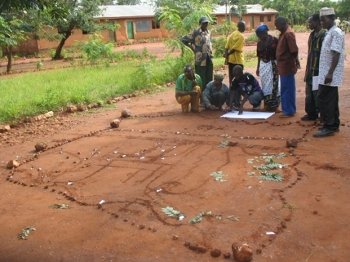 ‘Indigenous people and other rural communities inhabit more than 50 percent of the world’s land, across all continents except Antarctica. Their stewardship of Earth’s natural resources supports as many as 2.5 billion people with food, water, fuelwood and other life essentials. Less well-known, but also vitally important, is the role of community land in global efforts to avoid runaway climate change and achieve sustainable development. Of the 17 Sustainable Development Goals (SDGs) endorsed by the world’s governments, five directly address the role of land in securing humanity’s future, and three specifically call for securing community land rights. Sustainable land use, by providing a cost-effective way to sequester carbon dioxide, also offers huge climate benefits. It is no exaggeration that achieving both SDG 13 on climate action and national commitments under the Paris Agreement of the UN Framework Convention on Climate Change depends in large part on better land stewardship.
‘Indigenous people and other rural communities inhabit more than 50 percent of the world’s land, across all continents except Antarctica. Their stewardship of Earth’s natural resources supports as many as 2.5 billion people with food, water, fuelwood and other life essentials. Less well-known, but also vitally important, is the role of community land in global efforts to avoid runaway climate change and achieve sustainable development. Of the 17 Sustainable Development Goals (SDGs) endorsed by the world’s governments, five directly address the role of land in securing humanity’s future, and three specifically call for securing community land rights. Sustainable land use, by providing a cost-effective way to sequester carbon dioxide, also offers huge climate benefits. It is no exaggeration that achieving both SDG 13 on climate action and national commitments under the Paris Agreement of the UN Framework Convention on Climate Change depends in large part on better land stewardship.
‘Yet despite this global imperative, communities’ land rights are being undercut. Globally, national laws recognize only 10 percent of land as belonging to communities, with another 8 percent designated for their use. Even less is registered and titled to communities. In Africa, Latin America and Asia, many countries neither recognize community land nor adequately protect customary tenure systems handed down through generations…
‘Historically, community land covered all or most of the land area of many countries. Today, more than 50 percent of the world’s territory still remains in community hands, with the greatest amount in Africa.
Land and its natural resources are critical assets for rural communities and indigenous peoples, and central to developing country efforts to achieve many SDGs. Community land delivers food, water, fuelwood, medicinal plants and other critical resources, while providing inhabitants with security, status, social identity and a safety net.
‘Most community land around the world is held under customary tenure systems. These traditional institutions and customs historically provided communities with tenure security. But growing threats from outside these communities are leading to insecurity and loss of land.
‘Illegal logging is rampant in many heavily forested countries like Brazil, while land acquisitions for economic development purposes are on the rise around the world. Competition for land is intensifying as global demand rise for foods, fuels, minerals, fibers, wood products and other products. In many countries, companies, their investors and powerful local political and economic elites are acquiring land with government support and securing it for long periods of time. At the same time, customary tenure systems are weakening and no longer able to safeguard community land.
Land Tenure and Climate Mitigation: A Golden Opportunity
‘At a global level, one of the greatest benefits of securing community lands is their enormous potential for climate mitigation. By sequestering and storing carbon, managed forests and other landscapes support progress on SDG 13. A quarter of all GHG emissions comes from deforestation and other land use changes, although the rate varies widely across regions. For example, converting forests to farmland and other uses account for almost half of Latin America’s total emissions.
‘Given the intensifying destruction caused by climate change impacts, securing community land for climate mitigation is a low-cost, high-benefit investment…
‘There is a strong and compelling environment and development case to be made for securing community lands. Given the significant local, national and global benefits to be gained, making community land rights a priority agenda item offers a low-cost, high-reward investment for developing country governments and their development partners.
‘While each country has its own approach and unique circumstances for securing community lands, some important common measures can and must be introduced wherever they are absent. In particular, governments should prioritize:
- Establishing strong community land rights laws. Statutory laws that do not adequately protect community land rights should be reformed or replaced by new supportive legislation. For instance, the laws in Bolivia and Colombia recognize indigenous land rights, but do not provide indigenous peoples with sufficient legal protections.
- Establishing clear community land formalization procedures. Legislation and implementing regulations should provide a clear, accessible procedure for communities to register and document their land rights. Governments should simplify overly complex formalization procedures, amend steps that impose difficult burdens, and provide responsible agencies with the human and financial resources needed to document and protect all community lands.
- Leveling the playing field between communities and companies. Governments should strengthen monitoring and oversight of companies with land-based operations, and require companies to receive the full, free, prior and informed consent (FPIC) of affected communities. In addition, governments should ensure that industrial natural resource concessions are not allocated on community lands while applications for community land titles are pending.
‘If and when community lands across the world are properly secured, countries can accelerate progress on many SDGs as well as their climate targets. Given the looming threat posed to both environmental and development progress by climate change, the time to secure these lands is now.’
Read the entire commentary: Land Matters: How Securing Community Land Rights Can Slow Climate Change and Accelerate the Sustainable Development Goals, by Peter Veit, Director, Land and Resource Rights Initiative, World Resources Institute
Read more on ABCG’s work on Land and Resource Tenure Rights
Photo: Participatory Land Use by ABCG


Add a Comment